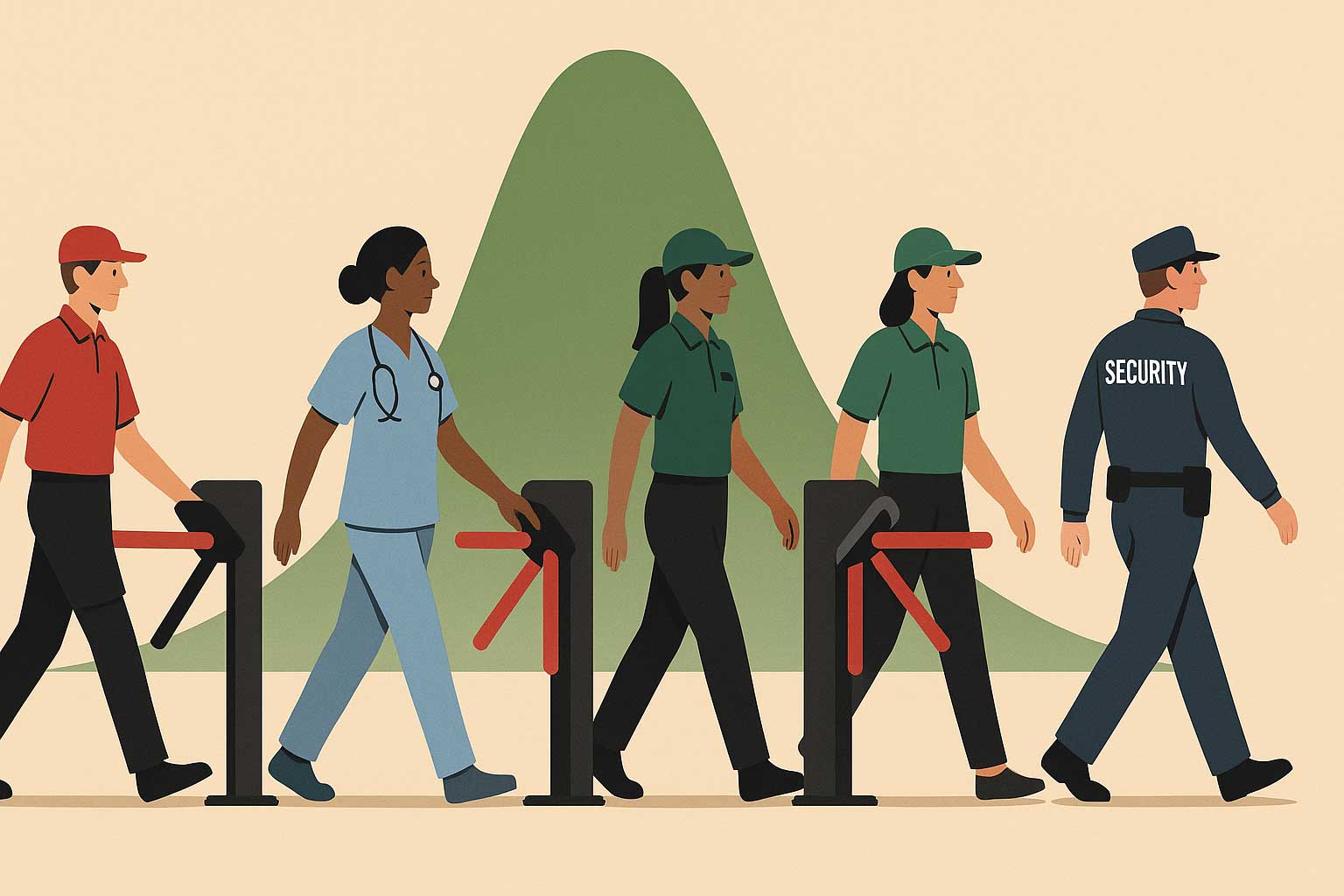It’s easy to assume the uniform business is all about fabrics, fits, and finding the one employee in the fleet who can make a size medium look like a million dollars. Yet behind the scenes, a far quieter force shapes how many shirts, boots, badges, scrubs, aprons, polos, and parkas flow through a distributor’s warehouse each year. That force is turnover — the rate at which humans come and go from uniform-wearing jobs. People leave, people start, uniforms get ordered, and the cycle keeps spinning.
This isn’t an exhaustive academic study. It’s a breezy tour through several major uniform markets, a sweep of recent data, and a look at why turnover is one of the strongest drivers of uniform consumption. Think of it as a friendly reminder that the labor market and your inventory shelf are closer cousins than many people realize.
Where the Turnstile Spins the Fastest
Some sectors practically hum with motion. Walk into a fast-food restaurant and you’ll often find a workforce that has turned over once, sometimes twice, in a single year. Several industry reports place quick-service restaurant turnover somewhere around the 130%–150% annual range. That means a crew of 50 might require 65 to 75 replacement uniform kits per year, not including size changes or accidental ketchup-related tragedies.
Grocery stores and general retail live in the same neighborhood, just at a slightly calmer address. Their turnover typically sits somewhere between 50% and 70%. Hospitality, meanwhile, is the true wild card. Hotels, resorts, and casinos often see annual turnover racing into the 70%–150% zone depending on the role. Housekeeping and banquet staff, in particular, seem to treat the employee entrance like a revolving door.
Contract security occupies a special place on the high-churn spectrum. Turnover can reach 100% in a typical year and soar well above that in certain markets. The uniform implications are obvious: constant new-hire kits, high loss rates, and a customer base that desperately wants uniform simplicity.
Transportation is similarly dynamic, but for different reasons. The trucking world often sees driver turnover near or above 90%. It’s less that drivers leave the industry and more that carriers swap them around like baseball cards. Every jump from Company A to Company B triggers a brand new set of logo’d gear.
The Middle of the Pack
The middle of the turnover curve is home to the industries where churn exists but doesn’t dominate the conversation. Hospitals, airlines, large manufacturers, and utility companies all live in this zone. Nurse turnover hovers around 16%–18%. Airline ground operations and customer service roles have similar figures. Manufacturers and industrial plants vary wildly but generally land somewhere between 15% and 25%.
These sectors may not be replacing entire workforces every year, but their sheer scale — hundreds or thousands of workers under one employer — means that even moderate turnover delivers steady, predictable uniform volume. In hospitals, for example, the difference between 12% and 18% turnover can translate into thousands of scrub sets.
And these markets come with their own quirks. Airlines add complexity through tailoring, climate-specific garments, and long cycles of brand refresh. Industrial and utilities programs bring FR requirements, union rules, laundering contracts, and regulated replacement schedules. Even if turnover is tame, the uniforms are anything but.
Low Turnover but High Stakes
Law enforcement, fire services, and military personnel historically fall on the lower end of the turnover curve. Many agencies still see annual attrition in the low-to-mid-teen percentages, though the past few years have been rougher on retention. Regardless of the exact number, these are not industries where the entire workforce flips over each year.
Uniform demand here is driven less by churn and more by the lifecycle of gear. Police departments spend heavily on initial outfitting: body armor, duty gear, outerwear, dress uniforms, footwear. The items are expensive, regulated, and built for years of service. But nothing lasts forever. Trousers wear out, carriers sag, badges scratch, specs change, and promotions bring new rank insignia. Fire and military sectors are even more controlled, with NFPA and MIL-spec requirements dictating replacement cycles in slow, predictable waves.
These programs don’t deliver the constant churn found in quick-service restaurants or security, but they deliver depth — technical garments, long-term contracts, and a level of brand trust that suppliers must consistently earn.
A Bell Curve of Uniform Turnover
This isn’t a scientific graph so much as a sketch in the margin of a uniform distributor’s notebook, but it captures the broad rhythm of the uniform economy. Think of it as the “shape” of churn across the industries we serve.
|
Position on Curve |
Typical Annual Turnover |
Industries |
Uniform Rhythm |
|---|---|---|---|
|
Left tail (low) |
Around 5%–15% |
Fire, military, law enforcement, some utilities |
Slow, steady replacement; high-value kits; spec-driven purchasing |
|
Middle hump (moderate) |
Around 15%–30% |
Healthcare, airlines, manufacturing, transit |
Large programs with ongoing replacement; strong portals and allowance systems |
|
Right shoulder (high) |
Around 30%–60% |
Grocery, retail, hospitality |
Frequent new-hire onboarding; image wear turnover; multi-department complexity |
|
Right tail (very high) |
Around 60%–150%+ |
Fast food, security, trucking |
Workforce rotates annually; high churn; huge standardized volume; rapid turnaround |
This curve alone could guide a distributor’s entire business strategy. High-turnover accounts reward speed, in-stock programs, and simple ordering portals. Low-turnover accounts reward expertise, fit services, and the ability to manage technical specifications over many years. The middle blends both worlds.
Why Turnover Matters to the Uniform Trade
Uniform distributors have long understood that an industry’s churn rate shapes its soul. Turnover tells you whether your future is filled with pallets of standard-issue polos or carefully fitted tactical outer carriers. It tells you whether your warehouse needs deep inventory in ten colors or a quiet back room capable of handling ballistic panel insertions. It tells you when to build an employee-allowance portal, when to emphasize lifecycle warranties, and when to invest in embroidery machines that can spit out a thousand logos before lunch.
Turnover becomes, in its own understated way, a barometer. It predicts demand, shapes margins, and helps you decide which segments match your operational DNA. Some distributors thrive on the rush of high-churn accounts; others build moats around technical, low-churn sectors. Both strategies work — as long as you understand the human movement behind them.
Because at the end of the day, the uniform business isn’t really about the clothes. It’s about the people who wear them, the rate at which they enter and leave the jobs that require them, and the hidden math that turns human motion into supply chain momentum.
The turnstile keeps spinning, and if you listen closely enough, it almost sounds like opportunity.
Sources Used in Turnover Research:
Toast – https://pos.toasttab.com/blog/on-the-line/restaurant-turnover-rate
Homebase – https://www.joinhomebase.com/blog/restaurant-employee-turnover
NetSuite – https://www.netsuite.com/portal/resource/articles/human-resources/reduce-restaurant-employee-turnover.shtml
Hospitality Net – https://www.hospitalitynet.org/opinion/4118580.html
HR Cloud – https://www.hrcloud.com/blog/the-importance-of-employee-retention-in-the-hospitality-industry-strategies-for-hr-professionals
U.S. Bureau of Labor Statistics (JOLTS) – https://www.bls.gov/news.release/pdf/jolts.pdf
McKinsey – https://www.mckinsey.com/industries/retail/our-insights/how-retailers-can-attract-and-retain-frontline-talent-amid-the-great-attrition
TruRating – https://trurating.com/blog/employee-turnover-in-retail/
MyTotalRetail – https://www.mytotalretail.com/article/combatting-retail-turnover-the-roi-of-employee-education/
Grocery Dive – https://www.grocerydive.com/news/fmi-80-of-food-retailers-say-hiring-issues-are-hurting-business/606695/
Fountain – https://www.fountain.com/posts/hiring-in-the-grocery-industry-a-closer-look
NSI Nursing Solutions (2025 Report PDF) – https://www.nsinursingsolutions.com/documents/library/nsi_national_health_care_retention_report.pdf
NSI Nursing Solutions (2023 Report PDF) – https://schedule360.us/Documents/Library/NSI_National_Health_Care_Retention_Report.pdf
Celayix – https://www.celayix.com/blog/retain-employees-in-the-security-industry/
TrackTik – https://www.tracktik.com/resources/blog-articles/10-strategies-to-reduce-turnover-rates-increase-engagement-and-retain-your-security-officers/
CAL-SAGA – https://calsaga.org/the-californian-q4-2023-discover-how-to-reduce-turnover-increase-engagement-and-retain-your-security-officers/
OOIDA Foundation (PDF) – https://www.ooida.com/wp-content/uploads/2025/04/The-Churn-A-Brief-Look-at-the-Roots-of-High-Driver-Turnover-in-U.S.-Trucking.pdf
Commercial Carrier Journal – https://www.ccjdigital.com/economic-trends/article/15064753/driver-turnover-rate-holding-steady
PT Staffing – https://ptstaff.com/truck-driver-retention-strategies/
PERF – https://www.policeforum.org/staffing2023
Thomson Reuters – https://legal.thomsonreuters.com/blog/navigating-the-shift-trends-in-law-enforcement-staffing/
ABC News – https://abcnews.go.com/US/police-departments-face-vicious-cycle-challenges-retaining-recruiting/story?id=98363458
IACP – https://www.theiacp.org/resources/the-state-of-recruitment-retention-a-continuing-crisis-for-police
Reward Gateway – https://www.rewardgateway.com/blog/employee-turnover-rates-by-industry
BLS JOLTS Data Tables – https://www.bls.gov/jlt/data.htm




















